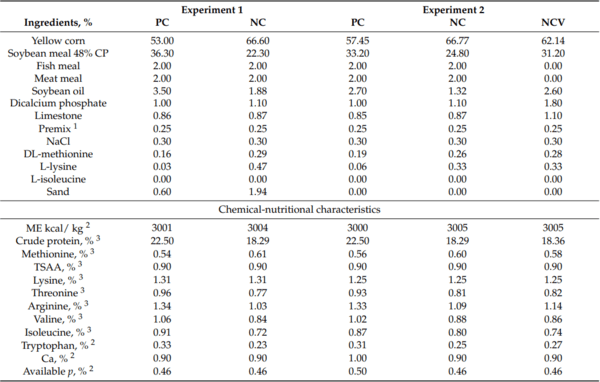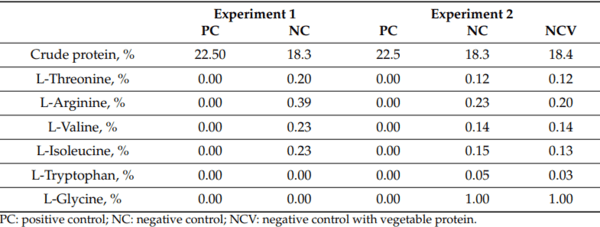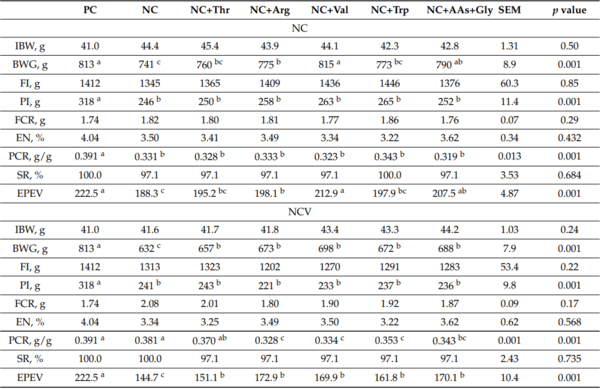Amino Acids Supplementation Affects Sustainability of Productive and Meat Quality, Survivability and Nitrogen Pollution of Broiler Chickens during the Early Life
Author details:






1. Kim, J.H.; Patterson, P.H.; Kim, W.K. Impact of dietary crude protein, synthetic amino acid and keto acid formulation on nitrogen excretion. Int. J. Poult. Sci. 2014, 13, 429–436. [CrossRef]
2. Aletor, V.A.; Hamid, I.I.; Niess, E.; Pfeffer, E. Low-protein amino acids-supplemented diets in broiler-chickens: Effects on performance, carcass characteristics whole-body –composition and efficiencies of nutrient utilization. J. Sci. Food Agric. 2000, 80, 547–554. [CrossRef]
3. Attia, Y.A.; Bovera, F.; Al-Harthi, M.A.; Wang, J.; Kim, W.K. Multiple amino acid supplementations to low dietary protein diets: Effect on performance, carcass yield, meat quality and nitrogen excretion of finishing broilers under hot climate conditions. Animals 2020, 10, 973. [CrossRef] [PubMed]
4. Soares, K.R.; Lara, L.J.C.; Martins, N.R.S.; Silva, R.R.; Pereira, L.F.P.; Cardeal, P.C.; Teixeira, M.P.F. Protein diets for growing broilers created under a thermoneutral environment or heat stress. Anim. Feed Sci. Technol. 2020, 259, 114332. [CrossRef]
5. Abreu, A.R.C.; Araújo, I.C.S.; Vaz, D.P.; Saldanha, M.M.; Fontes, D.O.; Leão, P.A.; Ecco, R.; Lara, L.J.C. Performance, nutrient digestibility, and muscular evaluation of female broiler chickens fed different dietary protein levels and slaughtered at 38 or 46 days. Rev. Bras. Zootec. 2022, 51, e20210151. [CrossRef]
6. Aderibigbe, A.; Cowieson, A.J.; Sorbara, J.O.; Pappenberger, G.; Adeola, O. Growth performance and amino acid digestibility responses of broiler chickens fed diets containing purified soybean trypsin inhibitor and supplemented with a monocomponent protease. Poult. Sci. 2020, 99, 5007–5017. [CrossRef]
7. Wang, J.; Kong, F.; Kim, W.K. Effect of almond hulls on the performance, egg quality, nutrient digestibility, and body composition of laying hens. Poult. Sci. 2021, 100, 101286. [CrossRef]
8. Koerkamp, P.G.; Metz, J.H.M.; Uenk, G.H.; Phillips, V.R.; Holden, M.R.; Sneath, R.W.; Short, J.L.; White, R.P.P.; Hartung, J.; Seedorf, J.; et al. Concentrations and emissions of ammonia in livestock buildings in Northern Europe. J. Agric. Eng. Res. 1998, 70, 79–95. [CrossRef]
9. Ritz, C.W.; Fairchild, B.D.; Lacy, M.P. Implications of ammonia production and emissions from commercial poultry facilities: A review. J. Appl. Poult. Res. 2004, 13, 684–692. [CrossRef]
10. Chalova, V.I.; Kim, J.H.; Patterson, P.H.; Ricke, S.C.; Kim, W.K. Reduction of nitrogen excretion and emissions from poultry: A review for conventional poultry. World’s Poult. Sci. J. 2016, 72, 509–520. [CrossRef]
11. Van Emous, R.A.; Winkel, A.; Aarnink, A.J.A. Effects of dietary crude protein levels on ammonia emission, litter and manure composition, N losses, and water intake in broiler breeders. Poult. Sci. 2019, 98, 6618–6625. [CrossRef] [PubMed]
12. Drew, M.D.; Syed, N.A.; Goldade, B.G.; Laarveld, B.; Van Kessel, A.G. Effects of dietary protein source and level on intestinal populations of Clostridium perfringens in broiler chickens. Poult. Sci. 2004, 83, 414–420. [CrossRef] [PubMed]
13. Liu, N.; Wang, J.; Gu, K.; Deng, Q.; Wang, J. Effects of dietary protein levels and multienzyme supplementation on growth performance and markers of gut health of broilers fed a miscellaneous meal based diet. J. Anim. Feed. Sci. Technol. 2017, 234, 110–117. [CrossRef]
14. Baker, D.M. Problems and pitfalls in animal experiments designed to establish dietary requirements for essential nutrients. J. Nutr. 1986, 116, 2339–2349. [CrossRef]
15. Leclercq, B. Broiler quality: Considering the trio of genotype, quality and dietary amino acids. Arch. Geflügelkd. 1995, 10, 37–40.
16. Aletor, V.A.; Roth, F.X.; Paulicks, B.R.; Roth-Maier, D.A. Growth, body-fat deposition, nitrogen excretion and efficiencies of nutrients utilization in broiler-chicks fed low-protein diets supplemented with amino acids, conjugated linoleic acid or an—Glucosidase inhibitor. Arch. Geflügelk. 2001, 66, 21–30.
17. Aletor, V.A.; Ede, K.; Becker, K.; Paulicks, B.R.; Roth, F.X.; Roth-Maier, D.A. The effects of conjugated linoleic acids or an alpha-glucosidase inhibitor on tissue lipid concentrations and fatty acid composition of broiler chicks fed a low-protein diet. Poult. Sci. 2003, 82, 796–804. [CrossRef]
18. Attia, Y.A.; Bovera, F.; Abd-El-Hamid, A.E.; Tag EL-Din, A.E.; Al-Harthi, M.A.; Nizza, A.; Elharidy, R.M. Effect of dietary protein concentrations, amino acids and conjugated linoleic acid supplementations on productive performance and lipid metabolism of broiler chicks. Ital. J. Anim. Sci. 2017, 16, 563–572. [CrossRef]
19. Abd El-Rahman, S.A.; Attia, Y.A. Response of Norfa white egg breeders to amino acid supplementation to low protein diets. Archiv. Geflügelk. 2022, 66, 35–42.
20. Corzo, A.; Schilling, M.W.; Loar, R.E.; Mejia, L.; Barbosa, L.C.G.S.; Kidd, M.T. Responses of Cobb × Cobb 500 Broilers To Dietary Amino acid density regimens. J. Appl. Poult. Res. 2010, 19, 227–236. [CrossRef]
21. Attia, Y.A.; Hassan, R.A.; Tag El-Din, A.E.; Abou- Shehema, B.M. Effect of ascorbic acid or increasing metabolizable energy level with or without supplementation of some essential amino acids on productive and physiological traits of slow-growing chicks exposed to chronic heat stress. J. Anim. Physiol. Anim. Nutr. 2011, 95, 744–755. [CrossRef] [PubMed]
22. Lilly, R.A.; Schilling, M.W.; Silva, J.L.; Martin, J.M.; Corzo, A. The effects of dietary amino acid density in broiler feed on carcass characteristics and meat quality. J. Appl. Poult. Res. 2011, 20, 56–67. [CrossRef]
23. Hafez, M.H.; Attia, Y.A. Challenges to the poultry industry: Current perspectives and strategic future after the COVID-19 outbreak. Front. Vet. Sci. 2020, 7, 00516. [CrossRef] [PubMed]
24. Hafez, M.H.; Attia, Y.A.; Bovera, F.; Khafaga, A.F.; Abd El-Hack, M.E.; de Olviera, M.C. SARS-CoV-2 impact on the poultry industry and environment. Environ. Sci. Pollut. Res. 2021, 28, 44833–44844. [CrossRef] [PubMed]
25. Kamran, Z.; Sarwar, M.; Nisa, M.; Nadeem, M.A.; Mahmood, S.; Babar, M.E.; Ahmed, S. Effect of Low-Protein Diets Having Constant Energy-to-Protein Ratio on Performance and Carcass Characteristics of Broiler Chickens from One to Thirty-Five Days of Age. Poult. Sci. 2008, 87, 468–474. [CrossRef] [PubMed]
26. Namroud, N.F.; Shivazad, M.; Zaghari, M. Effects of Fortifying Low Crude Protein Diet with Crystalline Amino Acids on Performance, Blood Ammonia Level, and Excreta Characteristics of Broiler Chicks. Poult. Sci. 2008, 87, 2250–2258. [CrossRef] [PubMed]
27. Ospina-Rojas, I.C.; Murakami, A.E.; Moreira, I.; Picoli, K.P.; Rodrigueiro, R.J.B.; Furlan, A.C. Dietary glycine+serine responses of male broilers given low-protein diets with different concentrations of threonine. Br. Poult. Sci. 2013, 54, 486–493. [CrossRef] [PubMed]
28. Waldroup, P.W.; Mitchell, R.J.; Payne, J.R.; Hazen, K.R. Performance of chicks fed diets formulated to minimize excess levels essential amino acids. Poult. Sci. 1976, 55, 243–253. [CrossRef] [PubMed]
29. Parr, J.F.; Summers, J.D. The effect of minimizing amino acid excesses in broiler diets. Poult. Sci. 1991, 70, 1540–1549. [CrossRef] [PubMed]
30. Han, Y.; Suzuki, H.; Parsons, C.M.; Baker, D.H. Amino acid fortification of a low-protein corn and soybean meal diet for chicks. Poult. Sci. 1992, 71, 1168–1178. [CrossRef] [PubMed]
31. Dean, D.W.; Bidner, T.D.; Southern, L.L. Glycine Supplementation to Low Protein, Amino Acid-Supplemented Diets Supports Optimal Performance of Broiler Chicks1. Poult. Sci. 2006, 85, 288–296. [CrossRef] [PubMed]
32. Hilliar, M.; Hargreave, G.; Girish, C.K.; Barekatain, R.; Wu, S.B.; Swick, R.A. Using crystalline amino acids to supplement broiler chicken requirements in reduced protein diets. Poult. Sci. 2020, 99, 1551–1563. [CrossRef] [PubMed]
33. Aviagen. Arbor Acers Broiler Management Handbook. 2018. Available online: https://eu.aviagen.com/assets/Tech_Center/ AA_Broiler/AA-BroilerHandbook2018-EN.pdf (accessed on 20 March 2022).
34. National Research Council, NRC. Nutrient Requirements of Poultry, 9th ed.; National Academy of Sciences; National Research Council: Washington, DC, USA, 1994.
35. Association Official Analytical Chemistry. AOAC Official Methods of Analysis, 19th ed.; Association Official Analytical Chemistry: Washington, DC, USA, 2007.
36. SAS Institute. SAS® User’s Guide: Statistics; Version 6 Edition; SAS Institute Inc.: Cary, NC, USA, 1996.
37. Jensen, L.S.; Mendonca, C.X., Jr. Amino acid nutrition of broilers during the grower period. In Georgia Nutrition Conference for the Feed Industry; University of Georgia: Athens, GA, USA, 1988; pp. 76–83.
38. Cuca, M.; Jensen, L.S. Arginine requirements of starting chicks. Poult. Sci. 1990, 69, 1377–1382. [CrossRef] [PubMed]
39. Kim, E.J.; Utterback, P.L.; Parsons, C.M. Comparison of amino acid digestibility coefficients for soybean meal, canola meal, fish meal, and meat and bone meal among 3 different bioassays. Poult. Sci. 2012, 91, 1350–1355. [CrossRef] [PubMed]
40. Barua, M.; Abdollahi, M.R.; Zaefarian, F.; Wester, T.J.; Girish, C.K.; Ravindran, V. Standardized ileal amino acid digestibility of protein sources for broiler chickens is influenced by the feed form. Poult. Sci. 2020, 99, 6925–6934. [CrossRef]
41. Ravindran, V.; Hew, L.I.; Ravindran, G.; Bryden, W.L. Apparent ileal digestibility of amino acids in dietary ingredients for broiler chickens. Anim. Sci. 2005, 81, 85–97. [CrossRef]
42. Smith, R.E. Assessment of the availability of the amino acid in fish meal, soybean meal and feather meal by chick growth assay. Poult. Sci. 1968, 47, 1624. [CrossRef]
43. Miller, D.; Kifer, R.R. Factors affecting protein evaluation of fish meal by chick bioassay. Poult. Sci. 1970, 49, 999–1004. [CrossRef]
44. Boorman, K.N.; Burgess, A.D. Responses to amino acids. In Nutrient Requirements of Poultry and Nutritional Research; Poultry Science Symposium No 19; Fishere, C., Boorman, C.N., Eds.; Butterworths: Edinburgh, UK, 1986; pp. 99–123.
45. Griminger, P.; Scott, H.M.; Forbes, R.M. The effect of protein level on the tryptophan requirement of the growing chick. J. Nutr. 1956, 59, 67–76. [CrossRef]
46. Rogers, S.R.; Pesti, G.M. The influence of dietary tryptophan on broiler chick growth and lipid metabolism as mediated by dietary protein levels. Poult. Sci. 1990, 69, 746–756. [CrossRef]
47. Maynard, C.W.; Kidd, M.T.; Chrystal, P.V.; McQuade, L.R.; McInerney, B.V.; Selle, P.H.; Liu, S.Y. Assessment of limiting dietary amino acids in broiler chickens offered reduced crude protein diets. Anim. Nutr. 2022, 10, 1–11. [CrossRef]
48. D’Mello, J.P.F. Amino acid imbalances, antagonisms and toxixities. In Amino Acid in Farm Animal Nutrition; D’Mello, J.P.F., Ed.; CAB International: Wallingford, UK, 1994; pp. 63–98.
49. Lipstein, B.; Bornstein, S.; Bartov, I. The replacement of some of the soybean meal by the first limiting amino acids in practical broiler diets. 3. Effects of protein concentration and amino acid supplementation in broiler finisher diets on fat deposition on the carcass. Br. Poult. Sci. 1975, 16, 627–635. [CrossRef]
50. Moran, E.T., Jr.; Bushong, R.D.; Bilgili, S.F. Reducing dietary crude protein for broilers while satisfying amino acid requirements by least-cost formulation: Live performance, litter composition, and yield of fast-food carcass cute of six weeks. Poult. Sci. 1992, 71, 1687–1694. [CrossRef]
51. Jacob, J.; Blair, R.; Ibrahim, S.; Scott, T.; Newberry, R. Using reduced protein diets to minimize nitrogen excretion of broilers. Poult. Sci. 1995, 74 (Suppl. S1), 127.
52. Teekel, R.A.; Richardson, C.E.; Watts, A.B. Dietary protein effects on urinary nitrogen components of the hen. Poult. Sci. 1968, 47, 1260–1266. [CrossRef] [PubMed]
53. Jirjis, F.F.; Waibel, P.E.; Duke, G.E. Effects of dietary protein, methionine and lysine on urinary amino acid excretion in turkeys. Br. Poult. Sci. 1997, 38, 518–523.
54. Alfonso-Avila, A.R.; Cirot, O.; Lambert, W.; Létourneau-Montminy, M.P. Effect of low-protein corn and soybean meal-based diets on nitrogen utilization, litter quality, and water consumption in broiler chicken production: Insight from meta-analysis. Animal 2022, 16, 100458. [CrossRef]
55. Van Harn, J.; Dijkslag, M.A.; Van Krimpen, M.M. Effect of low protein diets supplemented with free amino acids on growth performance, slaughter yield, litter quality, and footpad lesions of male broilers. Poult. Sci. 2019, 98, 4868–4877. [CrossRef]
56. Abdel-Raheem, G.S.E.; Ibrahim, N.S.K.; Sayed, A.N.; Amen, O.A.; Mickdam, E. Impact of dietary supplementation of organic acids on the growth performance and immunity in broilers fed low protein diets. SVU Int. J. Vet. Sci. 2022, 5, 31–44.
57. Liu, S.Y.; Macelline, S.P.; Chrystal, P.V.; Selle, P.H. Progress towards reduced-crude protein diets for broiler chickens and sustainable chicken-meat production. J. Anim. Sci. Biotechnol. 2021, 12, 20. [CrossRef]
58. Fisher, C. Use of amino acids to improve carcass quality of broilers. Feed Mix 1994, 24, 17–20.
59. Neto, M.G.; Pesti, G.M.; Bakilli, R.I. Effects of betaine and methionine levels in broilers chickens fed different levels of energy and protein. Poult. Sci. 1998, 77 (Suppl. S1), 84.
60. Leclercq, B.; Chagneau, A.M.; Cochard, T.; Khoury, J. Comparative responses of genetically lean and fat chickens to lysine, arginine and non-essential amino acid supply. I. Growth and body composition. Br. Poult. Sci. 1994, 35, 687–696. [CrossRef]
61. Bunchasak, C.; Santoso, U.; Tanaka, K.; Ohtani, S.; Collado, C.M. The effect of supplementing methionine plus cystine to a low-protein diet on the growth performance and fat accumulation of growing broiler chicks. Asian-Austral. J. Anim. Sci. 1997, 10, 185–191. [CrossRef]










